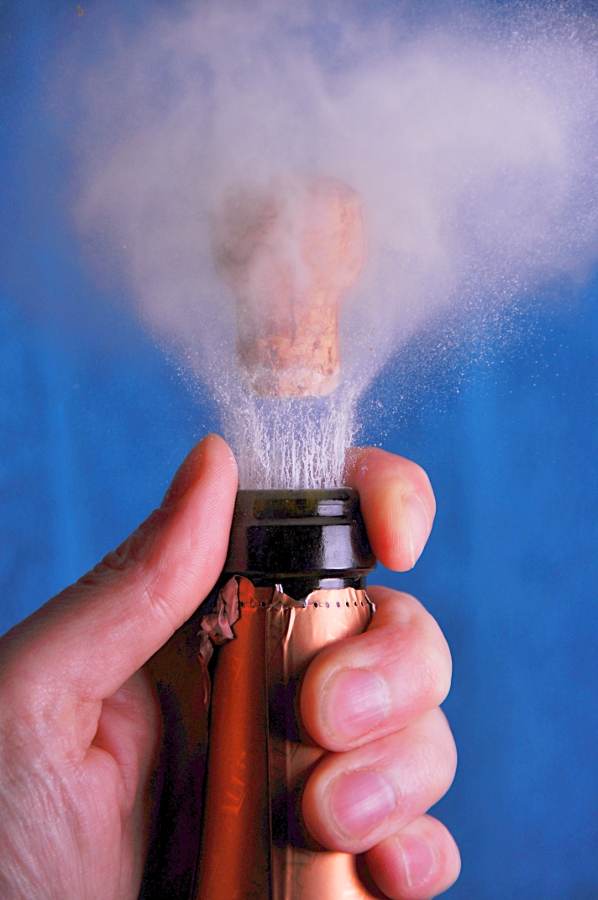It’s beginning to look a lot like Christmas. Oh, no, not to those of us enjoying the first warm days of spring and looking forward to summer. But for a consumer products company that needs to get something manufactured, boxed, shipped, and in the hands of customers by December 24th, Santa is at the door. Now.
Which explains why pre-order opportunities for pricey new gadgets are showing up on crowd-funding websites. This year, oenophiles (and their friends) are being enticed by not one, but two products promising better wine through technology: Kuvée: The Smart Wine Bottle that Keeps Wine Fresh, and Somm by SYNEK (pronounced “cynic”), A Wine Dispenser That Learns Your Palate.
Of the two, Kuvée has the far more elegant design. It is a wine bottle size device (slightly taller) with a built-in color touchscreen and wifi. The wine comes in 750ml aluminum bottles that are inserted into the bottom of the unit. Kuvée has partnered with several well-known wineries to deliver branded wines in its proprietary format, and they advertise that they will have 48 wines available when the product launches.
The aluminum bottles have RFID chips so when you insert one into Kuvée, it knows what wine it has and can display the wine label on the screen. Touch the screen and you can get more information about the wine. You can also provide feedback and order wines through the touch screen. To pour, just lift and tip Kuvée like you would a wine bottle. There’s a valve system inside that lets the wine out while preventing air from getting it.
Somm is a counter-top appliance with built-in pumping, refrigeration, and aeration systems. On the front, it has a pouring handle, a spout, and a door that provides access for inserting the 2.25 liter wine container called a “Sylo”. The wines have private label names as SYNEK purchases in bulk and fills the Sylos themselves. Somm’s Kickstarter page announces “100’s of wines available” though the small print says they will be launching with just 30.
Like the Kuvée, Somm recognizes which wine has been inserted it. One of the system’s more interesting innovations is that it uses this information to adjust the temperature and aeration settings to match the wine. Instead of a touchscreen, SYNEK provides an app for your smartphone or tablet for interacting with Somm. The apps will display information about the wine in the unit, allow you to rate it, and help you order more wine.
Though at first glance, these appear to be rather different products, both are being sold on the same value propositions:
1) to keep your wine fresh for 30 days after opening
2) to learn your preferences and help you select new wines
I have no doubts they can deliver. The technology to keep oxygen out of wine and extend its life after opening has been around for a quite a while; after all, it’s used inside box wines. (And before complaining about “that swill”, be aware that the Wine Spectator has rated some box wines as high as 89 points). Recommending new wines based on what you’ve liked in the past is equally straight forward.
The big limitation here is the wines themselves. Even if both systems eventually do have hundreds of wines, that’s just a small fraction of the thousands of wines available worldwide. It’s not enough diversity to satisfy the true wine lover or to educate the new aficionado.
They come in proprietary containers, so you can’t just pop into the store to buy some more. You have to order the wines for these things in advance. To support hundreds of wines, each device will need thousands upon thousands of customers. Active customers. If they don’t achieve a large enough user base, there is a chance that each will be stuck with its small starter set of wines. Even worse, perhaps no wine if there aren’t enough sales to support the special containers. A risk that is increased by the fact that there are competing systems.
Finally, while I’m sure either system can deliver a decent glass of wine, I have serious doubts about ever getting a great glass of wine. Too many of those require aging in a container that permits slow aeration, something the anti-oxidation designs of Somm and Kuvée are specifically designed to prevent. (Nor do I see premier providers rushing to embrace these units.)
I think there are really interesting things going on with each of these systems. If they worked with any bottle instead of the proprietary containers available from each supplier (not a simple request, I understand), they would be a lot more exciting. As it is, I see a shortage of utility and a lot of limitations.
So, in the end, we are left with the question: Who do Somm or Kuvée really help? If your primary goal is to be able to have just a glass or two of wine a day without the rest going bad, there are better choices: either find one of the good box wines or invest in one of the wine preservation products that will work with any wine. On the other hand, if the goal is to learn more about wine, you will quickly run up against the limits of either Somm’s or Kuvée’s wine selection. Moreover, with the Somm you won’t even know who produced the wine, a further impediment to learning.
Bottom line? If you’re interested enough in one of these for yourself to plop down $200 (the current going pre-buy price for either) now for delivery in the fall, go for it. Hundreds of other people have. But if you are thinking of getting one as a gift… er… maybe your friend would prefer the equivalent value in wine?
 If you have read the About page on Oenophily, you know that I have some issues with wine ratings. Briefly stated, I think that they are both the beginning and end of too many people’s buying decision process. Wine just isn’t that simple and to find the most satisfying ones it’s necessary to look a little more deeply into the bottle.
If you have read the About page on Oenophily, you know that I have some issues with wine ratings. Briefly stated, I think that they are both the beginning and end of too many people’s buying decision process. Wine just isn’t that simple and to find the most satisfying ones it’s necessary to look a little more deeply into the bottle.
